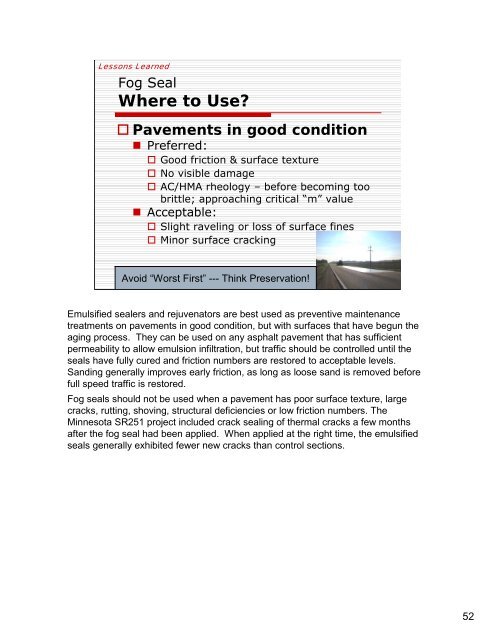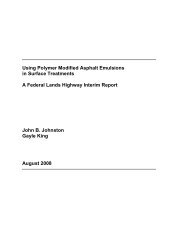Spray Applied Polymer Surface Seals - TSP2
Spray Applied Polymer Surface Seals - TSP2
Spray Applied Polymer Surface Seals - TSP2
You also want an ePaper? Increase the reach of your titles
YUMPU automatically turns print PDFs into web optimized ePapers that Google loves.
Lessons Learned<br />
Fog Seal<br />
Where to Use?<br />
Pavements in good condition<br />
• Preferred:<br />
Good friction & surface texture<br />
No visible damage<br />
AC/HMA rheology – before becoming too<br />
brittle; approaching critical “m” value<br />
• Acceptable:<br />
Slight raveling or loss of surface fines<br />
Minor surface cracking<br />
Avoid “Worst First” --- Think Preservation!<br />
Emulsified sealers and rejuvenators are best used as preventive maintenance<br />
treatments on pavements in good condition, but with surfaces that have begun the<br />
aging process. They can be used on any asphalt pavement that has sufficient<br />
permeability to allow emulsion infiltration, but traffic should be controlled until the<br />
seals have fully cured and friction numbers are restored to acceptable levels.<br />
Sanding generally improves early friction, as long as loose sand is removed before<br />
full speed traffic is restored.<br />
Fog seals should not be used when a pavement has poor surface texture, large<br />
cracks, rutting, shoving, structural deficiencies or low friction numbers. The<br />
Minnesota SR251 project included crack sealing of thermal cracks a few months<br />
after the fog seal had been applied. When applied at the right time, the emulsified<br />
seals generally exhibited fewer new cracks than control sections.<br />
52
















